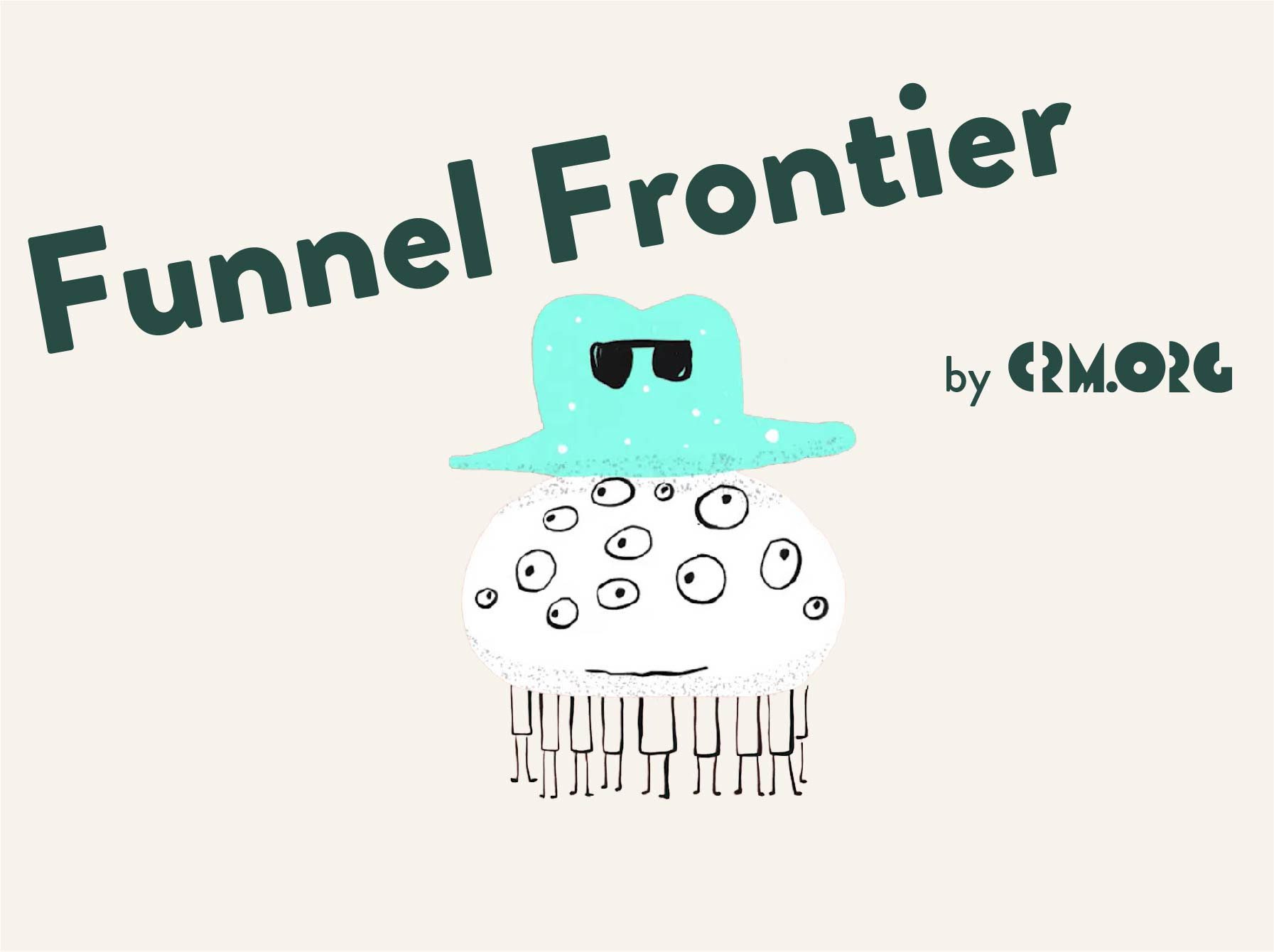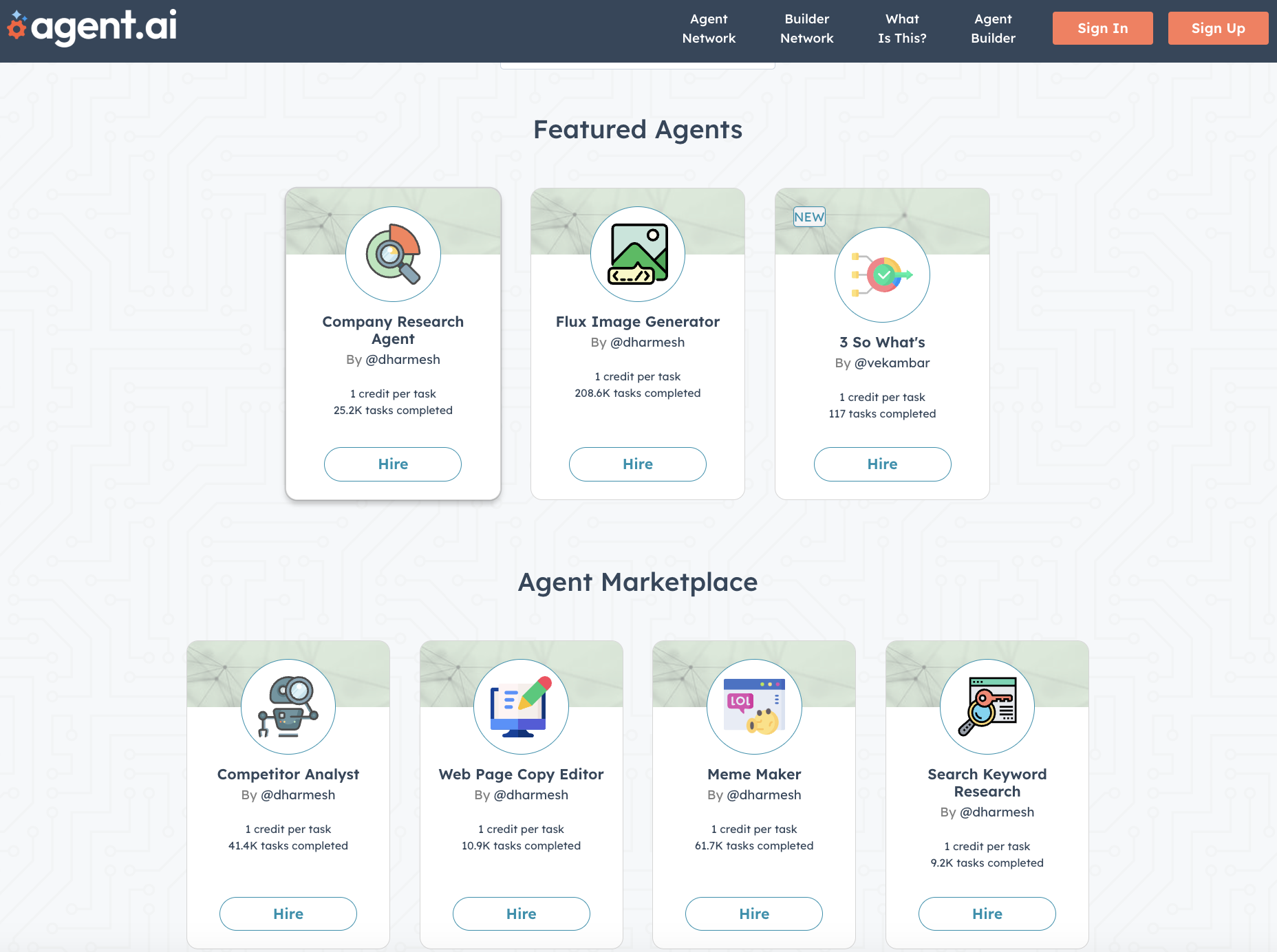
Farewell, Einstein Copilot. You Will Be Missed.
This week on Funnel Frontier: Salesforce retires Einstein Copilot as we know it. Here’s the scoop on why it’s gone and who’s going to replace it.

This week:
- Farewell, Einstein Copilot. You will be missed.
- Meet Agent.ai: platform with 258K users in 4 months. Are you joining?
Stat of the Week
Sales organizations that have fully implemented AI are 1.3 times more likely to experience revenue growth compared to those that haven’t. (Salesforce)
Farewell, Einstein Copilot. You will be missed.

Einstein Copilot is officially retired. Yep, the star AI assistant that wowed us less than a year ago has quietly left the building. Cue the bittersweet goodbye—it’s like losing the office buddy who always remembered your coffee order. Their replacement? Agentforce. Think sharper, faster, and here to take over the heavy lifting.
But why the name change? And what’s Salesforce trying to tell us?
Why Salesforce dropped Einstein Copilot?
The buzz started when Salesforce Architect Ashish Agarwal noticed that Einstein Copilot had been quietly rebranded as Agentforce (Default). Salesforce’s release notes say the change is purely cosmetic—same functionality, just a different badge.
“In Setup, you’ll see Agentforce or Agentforce (Default) for the agent name and type. This change won’t impact your implementations,” the company stated.
But, this move left us all wondering – why?
First, CEO Marc Benioff has been on a public crusade against Microsoft’s Copilot. Calling it “Clippy 2.0” and “repackaged ChatGPT,” Benioff isn’t here for assistive AI branding. This move feels like a deliberate pivot: Salesforce doesn’t want to assist—it wants to lead.
“In today’s Agentic world, you don’t need a Copilot to assist you (while you play the pilot),” Agarwal wrote in his recent LinkedIn post. “Nope, Agents are taking the controls themselves. They can now pilot the plane, handle turbulence, and even serve the in-flight snacks—all while you sit back, relax, and enjoy the ride.
And Salesforce? It’s banking on agents being the co-workers we actually want around.
Einstein Copilot may be gone, but its spirit lives on—just with a new outfit and a bigger job description. Salesforce isn’t just rebranding; it’s redefining AI’s role in business. Forget copilots. Agents are here to take charge, and Salesforce is betting they’ll reshape customer (and work) experiences for the better.
The Week @ CRM.org
Key CRM Statistics, 2025 Edition. CRM usage is exploding like some kind of champagne supernova. We survey all the stats that are fit to print.
18 Benefits of CRM Software. Watch your customer satisfaction soar—as long as you don't mention you forgot their… everything and had to look it up.
Weekly Bloom
Productive sans Productivity Guilt. Even on your winningest day, your mind can be a sci-fi villain: “Good, but not good enough—time to go to Mars." Here are six strategies for assuaging your internal antagonist.
Meet Agent.ai: platform with 258K users in 4 months. Are you joining?
It’s been only four months since Dharmesh Shah, HubSpot’s founder and CTO, unveiled Agent.ai at INBOUND 2024 last September. Fast-forward to today, and the platform already boasts a staggering 258,000 users—blowing past its initial 100,000-user goal.But wait… what even is Agent.ai?
In short, it’s Shah’s brainchild for a new era of work. Imagine a bustling marketplace where teams can scout, test, and deploy autonomous AI agents tailored to their specific needs.
Whether it’s sales, marketing, service, or operations, Agent.ai promises to plug seamlessly into any CX ecosystem—and it’s already making waves.
Shah envisions Agent.ai following the path of his previous side project ChatSpot (now Breeze Copilot), eventually folding into HubSpot’s broader CRM universe.
For now, though, it’s running independently—and staking its claim as a major player in agentic AI.

What’s driving Agent.ai’s success?
Agent.ai isn’t just another tech platform; it’s a sandbox for innovation. Alongside Shah’s pre-configured AI agents, the platform comes equipped with an Agent Builder—a low-code tool empowering users to create their own agents. And it’s getting traction:
14,422 builders are actively using the Agent Builder.
1,697 of them have already built their own custom AI agents.
In total, 3,420 agents have been developed, with 302 publicly shared for others to explore and review.
Even HubSpot CEO Yamini Rangan is on board, leveraging Agent.ai for internal projects. And Shah’s enthusiasm is contagious—he’s working seven days a week to improve the platform, calling it “a labor of love.”
How does Agent.ai work?
Agent.ai operates as a network of autonomous AI agents that help teams streamline tasks and supercharge productivity. Think:
Conversion Rate Optimizer Agent: Spots areas to improve on your website—whether it’s CTAs, images, or copy—to drive higher conversions.
Company Research Agent: Creates detailed profiles on B2B prospects, pulling data on founders, press coverage, and traffic stats.
Customer Executive Briefing Agent: Builds tailored guides for client meetings and can even convert them into audio files for on-the-go prep.
But that’s just the beginning. Shah’s vision is a platform where anyone can build and share agents, creating a thriving community-driven ecosystem—kind of like the App Store but for AI.
“Our vision is simple,” Shah declared during INBOUND 2024. “There’s an agent for that—for every marketing, sales, and customer service use case imaginable, including the ones we haven’t thought of yet.”
While platforms like Salesforce’s Agentforce are grabbing attention, Agent.ai is carving its own path by focusing on accessibility, community, and innovation. By enabling CX teams to build, test, and deploy AI Agents, Shah is shaping a future where businesses of all sizes can unlock the potential of agentic AI without breaking the bank.
Want to see for yourself? Sign up for free and get 100 credits to start exploring the possibilities of Agent.ai today.
Stellar Strategies: Tips & Tricks for Sales, Marketing & Service
You’re Spending $$$ on CRM—Is It Paying Off?
Preview text: Are you getting any ROI from your CRM? Here's a simple formula to check if your CRM is crushing it or crashing it.
You must have seen articles with those impressive CRM ROI stats like: “Businesses see $8.71 for every $1 spent on sales CRM software.”
But what does that even mean? And more importantly, how can you calculate whether your CRM is delivering on its promises?
Spoiler: Measuring CRM ROI isn’t just about math—it’s about understanding how your CRM drives revenue, streamlines processes, and transforms your customer relationships. Let’s break it down.
1. CRM ROI: What it is and why it matters?
CRM ROI measures how much value your CRM brings compared to what you’re spending on it. It’s not just about dollar signs; it’s about whether your CRM is saving time, boosting sales, or keeping customers around longer.
2. The formula: It’s simpler than you think
Here’s the magic equation:
CRM ROI = [(Net Gains - CRM Costs) ÷ CRM Costs] x 100
Example: You spent $45K on CRM (software, training, maintenance) and earned $120K in revenue.
CRM ROI = [(120K - 45K) ÷ 45K] x 100 = 166.7%
You’re making $1.67 for every dollar spent. Not too shabby, huh?
3. Metrics to measure CRM success
Wondering what to track to get your CRM ROI right? Don’t just look at one metric. Combine sales, marketing, and customer service data to get a full picture of your CRM’s impact.
Sales ROI:
Revenue per lead: Shows how well your CRM identifies profitable prospects.
Close rate: Tracks the percentage of leads turned into paying customers.
Marketing ROI:
Campaign ROI: Measures how much revenue your campaigns bring in.
Cost per lead (CPL): A low CPL means your CRM is doing its job.
Customer Service ROI:
Retention rate: High retention? Your CRM is building loyalty.
Average resolution time: Faster responses = happier customers.
4. Measure, adapt, and grow
CRM ROI isn’t static. Regularly track performance, pinpoint what’s working, and fix what’s not. Use real-time dashboards to monitor key metrics like conversion rates and customer satisfaction. Adjust strategies as needed to maximize returns.
5. Advanced insights: Think LTV and Non-Financial ROI
CRM ROI goes beyond immediate financial gains. Let’s take a step back to consider two often-overlooked aspects:
LTV: The Long-Term Payoff
Your CRM isn’t just a tool for tracking sales—it’s a goldmine for improving Customer Lifetime Value (LTV). By identifying upselling or cross-selling opportunities and nurturing loyalty, your CRM turns customers into long-term advocates.
Non-Financial ROI
Numbers aren’t the whole story. Consider these intangible benefits:
Team efficiency: Automation reduces manual workload, giving teams more time to focus on strategy.
Stronger relationships: CRM personalization builds trust and loyalty.
Smarter decisions: With data-driven insights, you’re no longer guessing—you’re growing.
Check out the full article for more advanced metrics, real-world examples, and actionable strategies!
Here’s How You Can Save Time and Deliver Better Customer Service with AI
Scaling personalized, 24/7 customer support isn’t just a dream—it’s table stakes in today’s cutthroat world of customer expectations. AAA Washington, one of North America’s roadside assistance powerhouses, cracked the code with AI, turning their service into a blend of speed, personalization, and human connection.
Here’s the kicker: this isn’t just about automation—it’s about making every interaction feel like a lifeline. Let’s break down how they pulled it off and what you can swipe for your business.
1. Zoom in on metrics that move the needle
AAA Washington zeroed in on the metrics that matter most: speed to answer, roadside response time, and “Keeping Members Informed” (KMI). With AI in their corner, they serve up real-time updates and proactive communication, making stressful roadside moments feel a little less chaotic.
Takeaway: What numbers scream “happy customers” for your business? Whether it’s slashing response times or providing crystal-clear updates, set your sights on the metrics that move the needle and let AI do the heavy lifting.
2. Turn “personalized” into your superpower
AAA’s AI of choice—Salesforce Agentforce—didn’t stop at answering questions. It leveled up personalization by recommending things like safe driving schools for new drivers and spotting potential service needs before customers even thought to ask.
Takeaway: Let AI do what it does best—connect the dots. Use real-time insights to deliver tailored solutions, whether it’s a proactive recommendation or a thoughtful follow-up. This isn’t just customer support; it’s customer delight.
3. Ditch the repetitive, master the moments
Membership status checks? Automated. Agents spending hours on routine calls? Not anymore. With mundane tasks out of the way, AAA’s team zeroes in on complex, high-stakes conversations—like talking down stressed-out drivers stranded on the freeway.
Takeaway: Free up your team to shine where it counts. Offload repetitive tasks to AI and let your people own the moments that build loyalty and trust.
4. AI as the sidekick, not the hero
AAA nailed the balance: AI wasn’t brought in to replace human agents—it was built to make them better. Think of it as the tech-powered sidekick that lets agents deliver empathy, precision, and all the human feels during critical moments.
Takeaway: Use AI to amplify your team’s talents. From smarter data access to instant recommendations, tech should be the Robin to your team’s Batman.
5. Double down on your brand promise
AAA’s brand is built on reliability, and AI plays a major role in delivering on that promise. Whether it’s a flat tire at midnight or insurance advice during a crisis, their members feel supported every step of the way.
Takeaway: AI isn’t just a tool; it’s a reflection of your brand’s commitment to your customers. Use it to create not just functional solutions, but memorable, loyalty-driving experiences that keep customers coming back.
Watch the full case study now and learn more actionable strategies to apply in your organization.
28 AI tools marketers swear by
AI is reshaping marketing faster than ever, but here’s the thing: relying solely on ChatGPT means you’re leaving powerful tools on the table.
From optimizing campaigns to creating personalized content at scale, AI offers marketers a massive advantage—when you know which tools to use.
Here are 28 standout tools, each designed to save you time, boost results, and transform how you connect with your audience.
1. Jasper.ai
Best for: Content creation
Why it’s great: Generate polished blogs, ad copy, and emails with intuitive prompts and pre-built templates. Jasper’s your all-in-one writing assistant.
2. Zapier
Best for: Workflow automation
Why it’s great: Eliminate manual tasks by automating lead data syncing, workflows, and campaign triggers. Your team’s productivity just leveled up.
3. MarketMuse
Best for: Content strategy
Why it’s great: Pinpoint SEO opportunities and optimize your content to dominate search rankings. MarketMuse makes strategic planning a breeze.
4. Predis.ai
Best for: Social media content
Why it’s great: Create branded posts, carousels, and videos in seconds. Built-in scheduling means you’re always ahead of the game.
5. CallRail’s Conversation Intelligence
Best for: Call analytics
Why it’s great: Transcribe, analyze, and improve customer calls with keyword and sentiment tracking. A smart way to refine your approach.
6. Howler.AI
Best for: Press releases
Why it’s great: Identify journalists who are the perfect match for your news, then craft and send targeted outreach. Hyper-targeted PR made simple.
We have to stop here (otherwise this will be too long to read), but you don’t.
There are 22 more waiting to take your marketing to the next level. Explore the full article for more insights.
Galactic Gourmet
CRM blips from around the web
Pipedrive Earns ISO 27701 Certification. Pipedrive’s latest certification highlights its commitment to safeguarding customer data. With enhanced systems for managing security and privacy at scale, Pipedrive ensures small businesses benefit from world-class data protection standards.
SAP & Microsoft Preview Joule-Copilot Integration. SAP and Microsoft’s Joule-Copilot integration lets users access data and automate tasks across platforms without switching apps, boosting productivity and efficiency. Plus, Joule expands into mobile and analytics.
HubSpot Releases 97 Updates in December. HubSpot launched 97 updates in December. Here are 13 game-changers you should learn how to start using right now, from new data permissions to feedback-linked tickets and advanced reporting tools.
Astronomical Assets
Significant moves in the past 7 days
Stock | Change | Close Price |
Freshworks Inc. (NASDAQ: FRSH) | +1.37 (+8.53%) | 17.44 USD |
monday.com (NASDAQ: MNDY) | +29.46 (+13.51%) | 247.66 USD |
DISCLAIMER: None of this is financial advice. This newsletter is strictly educational and is not investment advice or a solicitation to buy or sell any assets. Please be careful and do your own research.
If you'd like weekly CRM news delivered to your inbox, subscribe to Funnel Frontier!
